Written by admin.
Posted on February 2, 2010.
Filed under North Atlantic Gyre, Sea Dragon.
Tagged North Atlantic Gyre, Sea Dragon.
Today the ocean is so calm that we can take out the dinghy. We stand guard for a few hours, packed with life-vests, waterproof bags, binoculars, VHF (Very High Frequency) radios, fishing nets and diving gear until we see a windrow of sargassum. Lam, Joel, Mike and me jump in the boat and plunder one patch after the other like bees hunting for nectar. Joel dives into the water with a wetsuit to catch plastic from below, I’m using the nets, Lam is operating the boat and Mike is filming the whole thing. Again we fill up a bag in no time. Most of the plastic is partly eaten with visible bitemarks all over. From some plastic bottles only the handle is left. Who is eating this shit?
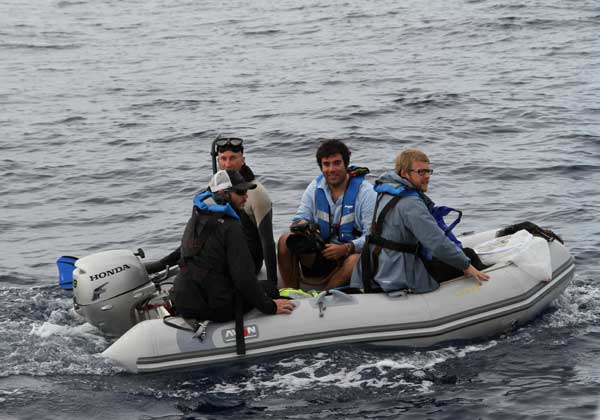

Just when the Sea Dragon calls in to say we are getting out of sight we hear a scary and alarming deflation sound, like a shark just took a bite of the air filled dinghy. Joel is hanging on the boat, but still in the water and all four of us look at each other for about three seconds in which we know that this is it. Than we notice the water in the boat which made Joels life-vest go off. A sincere long deep sigh is synchronicaly unleached. Youth memories are stored again for another occasion.
Back on the Sea Dragon we make a stunning discovery: a fish is caught in one of the plastic containers and it’s teeth seem to fit the bitemarks on the plastic debris. Is this the suspect we are looking for?

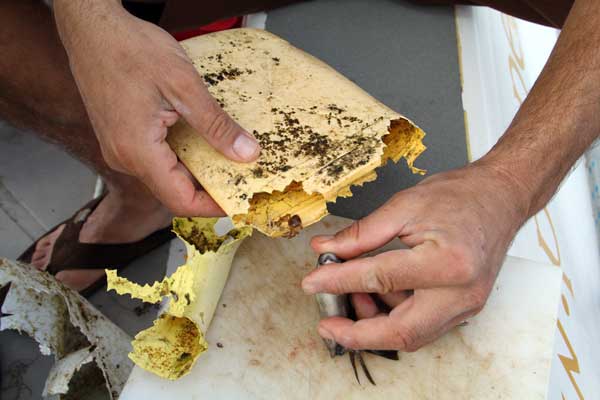
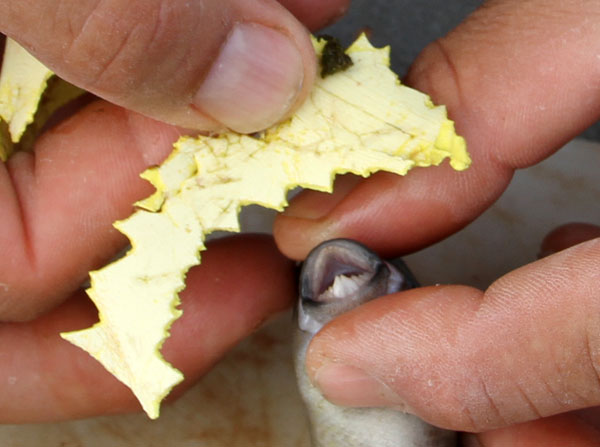
Written by admin.
Posted on February 1, 2010.
Filed under North Atlantic Gyre, Sea Dragon.
Tagged North Atlantic Gyre, Sea Dragon.
After days of waiting and lingering fear of finding nothing at all, we finally start to discover plastic. The closer we get to the center of the North Atlantic Gyre, big patches of sargassum come floating by. This seaweed with little airbubbles is part of a unique ecosystem. It thrives in a salty sea without surrounding land, the only one of it’s kind in the world. The Sargasso Sea is surrounded by the Atlantic Ocean and is collecting plastic debris due to the clockwise currents. Plastic flocks together with patches of sargassum which on their turn flock together in so called windrows, long lines of brown islands, floating on the water, hand in hand.
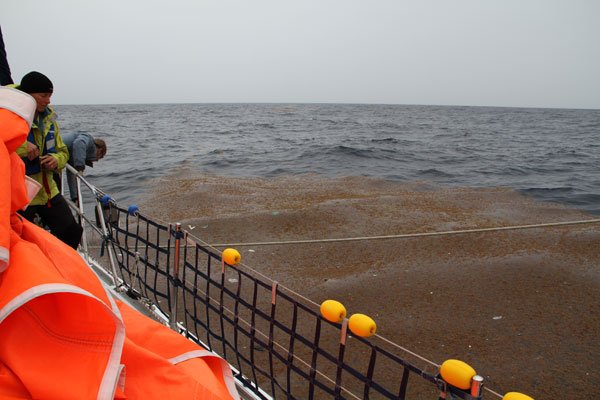
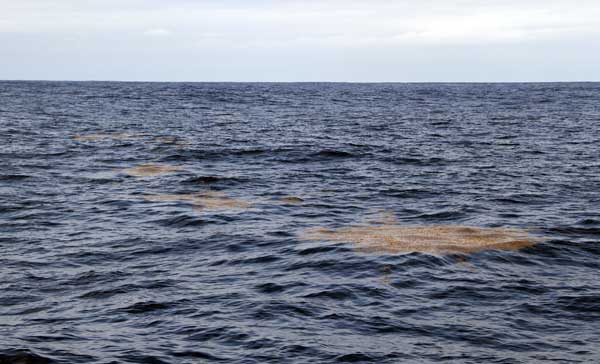
Within an hour we collect a garbage bag full of debris ranging from lighters to bottle caps, toothbrushes, pieces of crates, lids, safelty helmets, ropes, nets and tubes. Anything you can imagine which is made of floating plastic can be found here. However, only 30% of all plastics is floating, the rest lays at the bottom of the ocean.
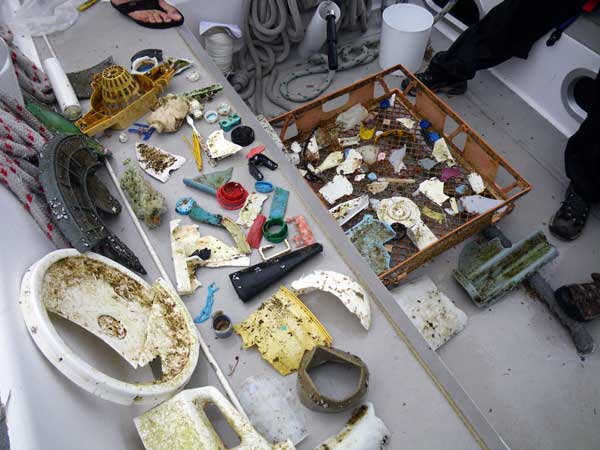
Written by admin.
Posted on January 31, 2010.
Filed under North Atlantic Gyre, Sea Dragon.
Tagged North Atlantic Gyre, Sea Dragon.
The weather is getting bad. There is to much wind to do the trawls and since we can not have more than 100 miles between each trawl, we decide to stop the boat and wait for better weather. This means however that we will be waiting for a stormfront we see approaching on the radar, like sitting ducks. Without sail or motor the boat rocks on the rhythm of the waves and since they go crescendo there are just a few people that stay physicaly ok. For one reason I’m one of them. I haven’t been sick at all, which is more than I can say of our watch team. Lam and Joel are in bad condition when the boat moves to much. Marjolijn had to throw up the first day and had a high fever at night but since she has an anti-sea sick patch on, she is fine. Sitting and waiting is bad for moral, especially when it starts raining and there is no plastic to be seen 360 degrees around. What s going on? Where is that trash people are talking about?
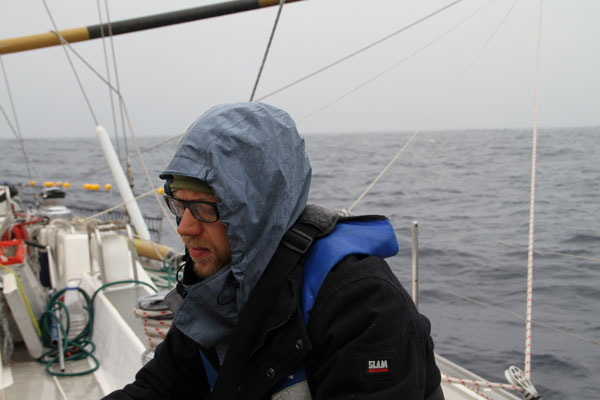
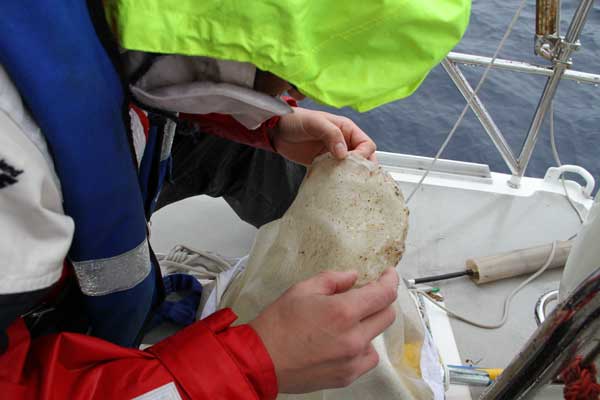
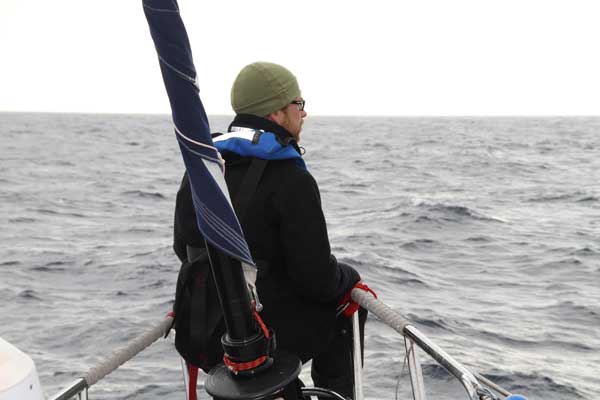
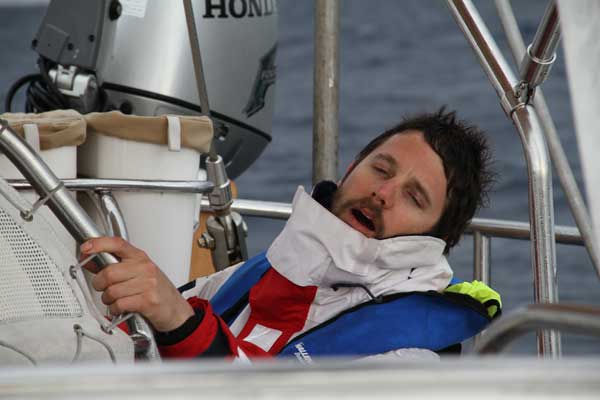
Written by admin.
Posted on January 31, 2010.
Filed under North Atlantic Gyre, Sea Dragon.
Tagged North Atlantic Gyre, Sea Dragon.
The weather is so good that we can make a short trip with the dinghy, the small motorboat we are carrying with us on board. Even on this expedition we see little or no plastic, which makes us wonder if the Atlantic Ocean is as polluted as the Pacific Ocean. More data needs to be collected over the next years first to come up with any conclusive answer. The currents and weather conditions are so influential on both location, movement and depth of the plastic particles that it is hard to say at the moment. On one hand I’m relieved that we don’t see as much as I expected, but at the other hand I’m also a bit dissapointed. I will have to rely much more on the trash washed ashore on the beaches of the islands at the borders of the gyre.
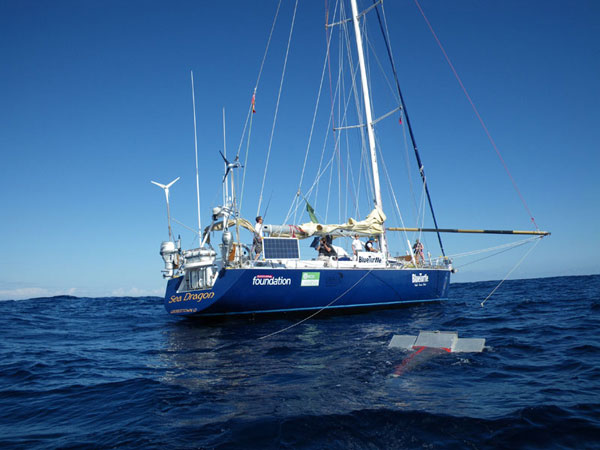
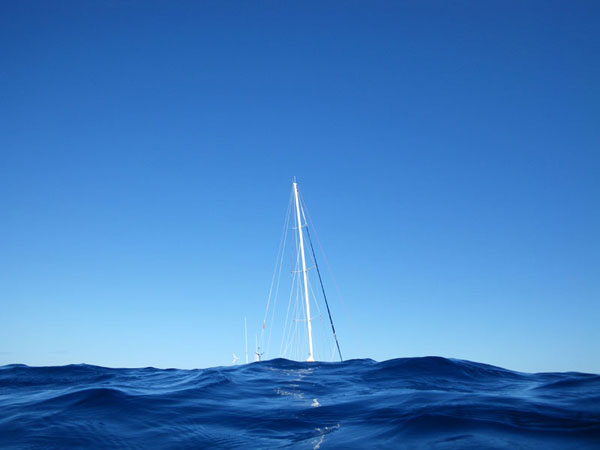
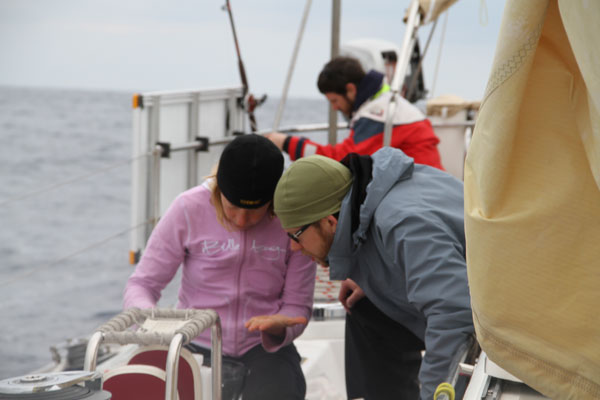
To comfort us, we are visited by a dozen dolphins, who swim and jump alongside the boat for about 10 minutes, and an hour later some humpback whales just pass us without paying much attention. On top of that we catch our first fish; a small bluefin tuna (not so many left according to different studies…), but it is to damaged to throw back. We cut it up and eat the freshest Sashimi ever, with a little regret in stead of wasabi. It has no plastic particles in its stomach. Another reassuring and/or dissapointing discovery.



Written by admin.
Posted on January 30, 2010.
Filed under North Atlantic Gyre, Sea Dragon.
Tagged North Atlantic Gyre, Sea Dragon.
The first two days we hardly see big pieces of plastic debris. Small chips of plastic (around 5 mm) are present however from day one and are increasing as we approach the North Atlantic Gyre. The sky is open, allowing the full moon to clear the deck at night like a spotlight. It is weird to get into the watch schedule which is constantly changing. Three groups of four people are doing five watches every 24 hours. During the day they last 6 hours (from 06:00 to 12:00 and from 12:00 to 18:00). At night they last 4 hours (from 18:00 to 22:00, from 22:00 to 02:00 and the toughest one from 02:00 to 06:00). We all cook and clean in turns and keep the ships log, writing down data relating to weather conditions, wind and location. After a few days the team runs like a machine, operating the 19 meter long boat day and night non stop.


Lam and Joel through the night goggles.
In the morning the sun penetrates through the clouds like a laser beam. Despite the apocalyptic aura we keep heading towards the horizon.

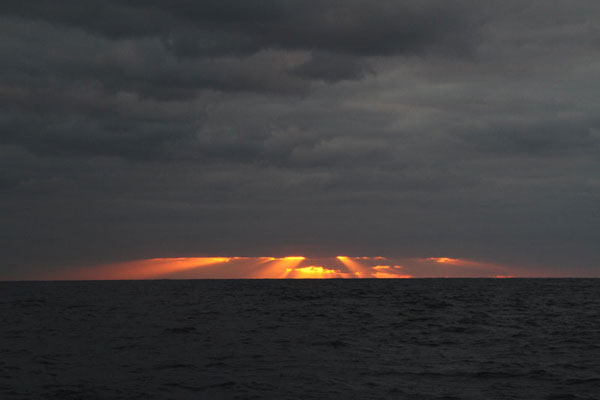
Written by admin.
Posted on January 28, 2010.
Filed under North Atlantic Gyre, Sea Dragon.
Tagged North Atlantic Gyre, Sea Dragon.
The weather is great so off we go! The crew consists of 13 people (God Almighty!), all birds of different feather. From scientists working for Algalita Marine Research Foundation measuring the amount of plastic floating on the surface (for the first time ever over the entire length of the Atlantic Ocean), to a writer and editor in chief of WEND, a magazine focussing on adventure, travel and conservation. From an independant videographer on his maiden voyage to Europe, to some students and sailing professionals. Our captain Clive was a skipper on the BT Global Challenge (2004) for which the Sea Dragon was initially build. He knows the ship like no one else and his main goal is obviously (and very reassuring) in the first place to bring us all safely to the other side.
We throw out our first plankton net to fish out small plastic particles and start looking out for the big pieces. Neptune seems to be willing to grand us a safe passage…



Last day on land! We decide to go to the beach to look for plastic. On first sight it looks like paradise, but if you look closer…..
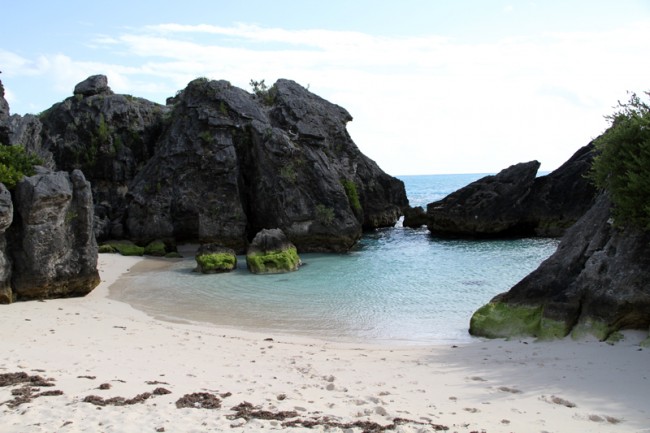
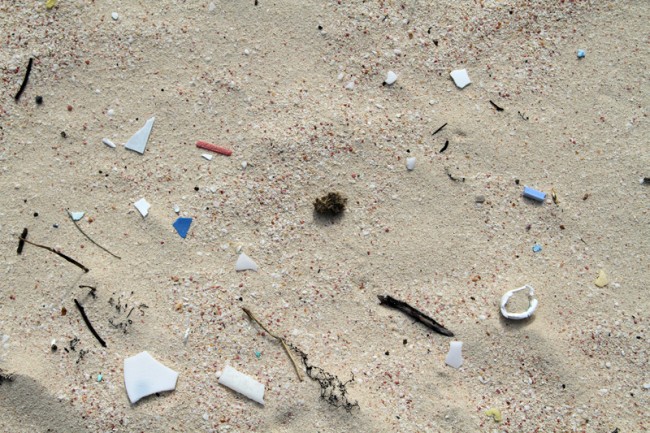
In 30 minute we collect 4 big bags (about 100 kilo) without any effort. It is hard to imagine how plastic there is in total on Bermuda… and that is just one island in the Atlantic Ocean.
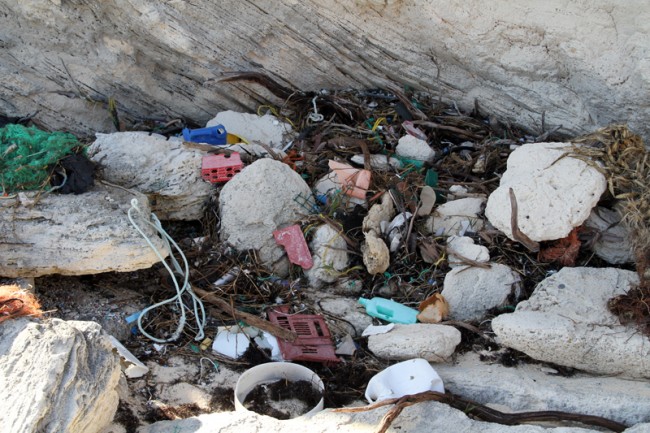
After 20 days of travel and work, passing by Dubai, Beijing and LA I arrive triple jet-lagged in Bermuda. Luckily the departure is delayed a bit because of some additional instalment of a CO2 sensor to measure the changing acidity of the ocean.
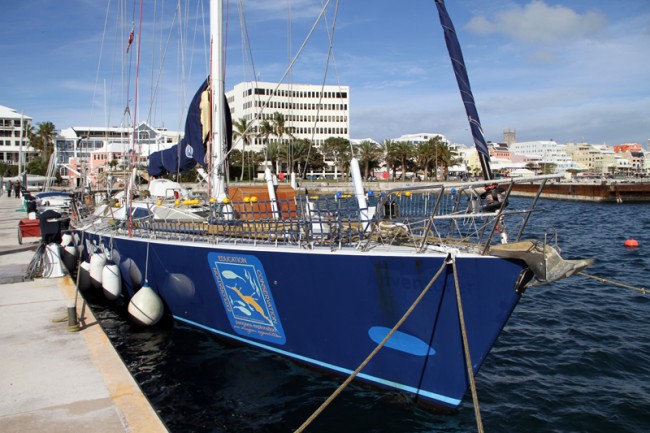
The crew is exited to leave however. Below captain Clive on right is pointing at the center of the North Atlantic Gyre, our first goal.
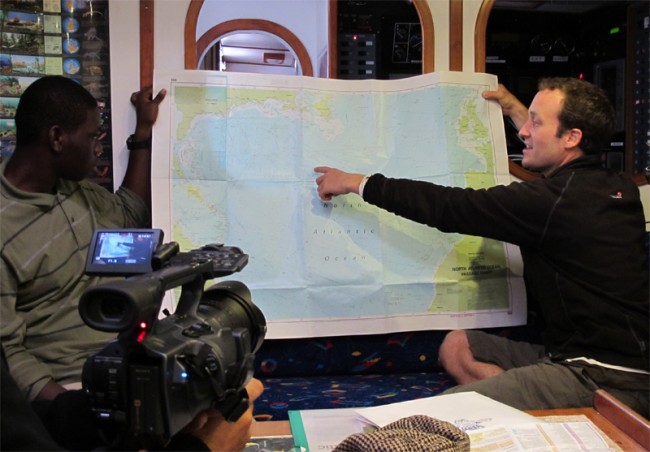
Written by admin.
Posted on September 17, 2009.
Filed under Plastic Reef, Research.
Tagged Research.
In September 2009 I went to Lagos, Portugal to meet the team of the Sea Dragon, a 19m steel hulled sailing vessel built in the UK in 2000. One of twelve identical yachts commissioned by Challenge Business, these boats took part in the toughest yacht race in the world, the BT Global Challenge, sailing around the world against prevailing winds and currents. In 2007 it was acquired by Pangaea Exploration LLC and refit to function as a research vessel with the aim to host and collaborate with different organisations and foundations investigating the pollution levels of our natural environment and the global impact on societies worldwide. In January 2010 I will join them together with Lam Moreels and Marjolijn Dijkman to cross the North Atlantic Gyre, from Bermuda to the Azores.
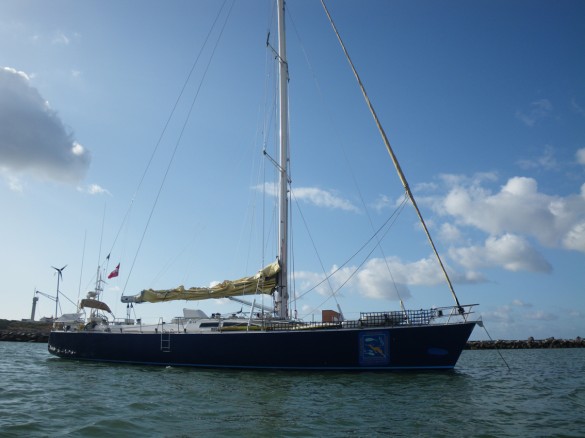
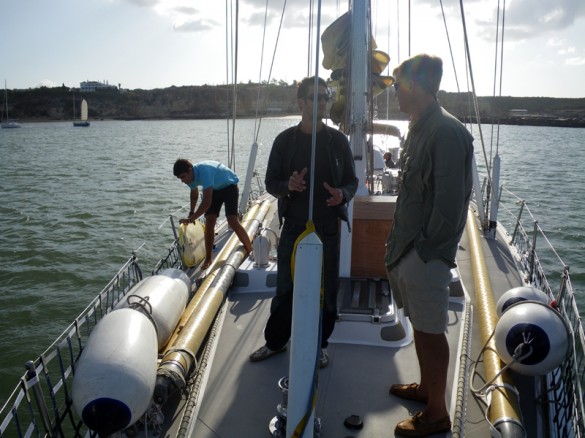
Lam Moreels talking to Ron Ritter of the Sea Dragon
Written by admin.
Posted on February 16, 2009.
Filed under North Pacific Gyre, Plastic Reef, Research.
Tagged North Pacific Gyre, Research.
In February 2009 I went to the Hawaiian Islands to collect more plastic. They are located in the middle of the North Pacific Gyre and get a lot of plastic flotsom on their beaches. For one day I joined the volunteer group B.E.A.C.H. who is collecting, categorising and counting every piece of plastic they find. They shipped five boxes after my departure which I melted on to the first Plastic Reef.
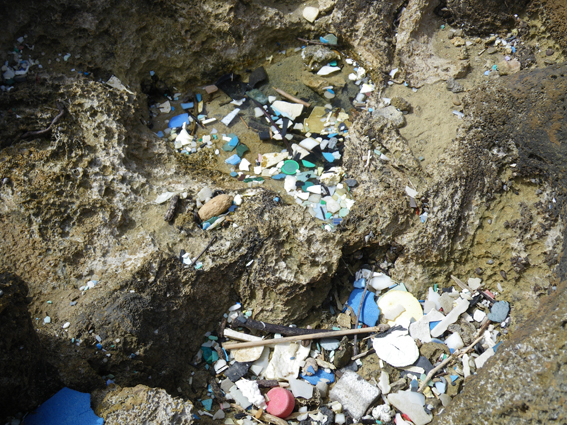
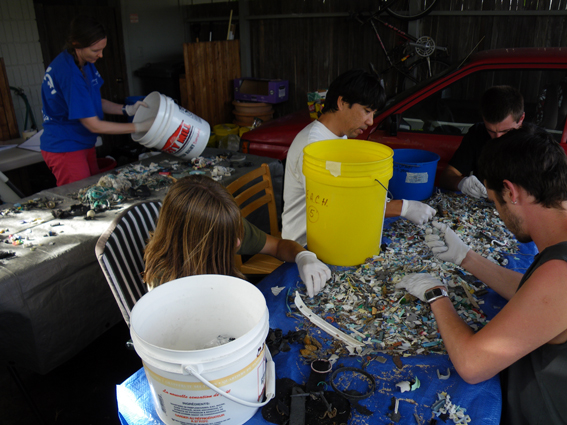
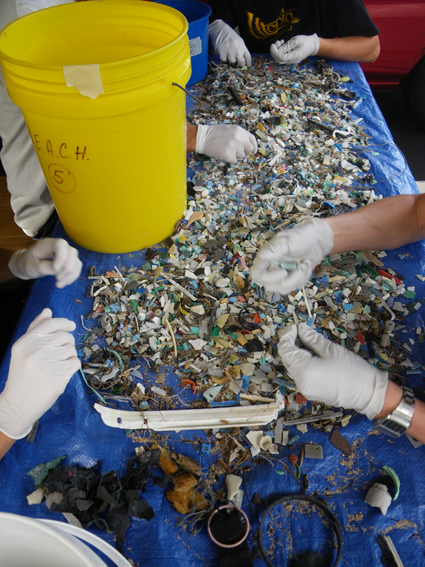
Beach Environmental Awareness Campaign Hawai`i (B.E.A.C.H.) is a non-profit, volunteer organization concerned with bringing awareness and solutions to the problem of marine debris and litter on Hawai`i’s beaches. B.E.A.C.H. organizes litter prevention campaigns, educational presentations to schools and community organizations and beach clean-ups in order to educate the community about the need to care for Hawai`i’s beaches, coastline and marine life.


































